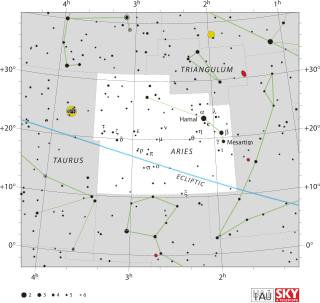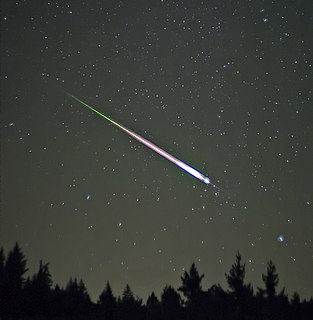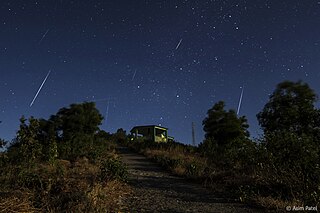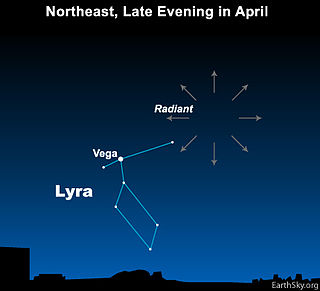
Aries is one of the constellations of the zodiac. It is located in the Northern celestial hemisphere between Pisces to the west and Taurus to the east. The name Aries is Latin for ram. Its old astronomical symbol is (♈︎). It is one of the 48 constellations described by the 2nd century astronomer Ptolemy, and remains one of the 88 modern constellations. It is a mid-sized constellation, ranking 39th overall size, with an area of 441 square degrees.

The Leonids are a prolific meteor shower associated with the comet Tempel–Tuttle, which are also known for their spectacular meteor storms that occur about every 33 years. The Leonids get their name from the location of their radiant in the constellation Leo: the meteors appear to radiate from that point in the sky. Their proper Greek name should be Leontids, but the word was initially constructed as a Greek/Latin hybrid and it has been used since. They peak in the month of November.

The Geminids are a prolific meteor shower caused by the object 3200 Phaethon, which is thought to be a Palladian asteroid with a "rock comet" orbit. This would make the Geminids, together with the Quadrantids, the only major meteor showers not originating from a comet. The meteors from this shower are slow moving, can be seen in December and usually peak around December 4–16, with the date of highest intensity being the morning of December 14. The shower is thought to be intensifying every year and recent showers have seen 120–160 meteors per hour under optimal conditions, generally around 02:00 to 03:00 local time. Geminids were first observed in 1862, much more recently than other showers such as the Perseids and Leonids.

A meteor shower is a celestial event in which a number of meteors are observed to radiate, or originate, from one point in the night sky. These meteors are caused by streams of cosmic debris called meteoroids entering Earth's atmosphere at extremely high speeds on parallel trajectories. Most meteors are smaller than a grain of sand, so almost all of them disintegrate and never hit the Earth's surface. Very intense or unusual meteor showers are known as meteor outbursts and meteor storms, which produce at least 1,000 meteors an hour, most notably from the Leonids. The Meteor Data Centre lists over 900 suspected meteor showers of which about 100 are well established. Several organizations point to viewing opportunities on the Internet. NASA maintains a daily map of active meteor showers.

The Perseids are a prolific meteor shower associated with the comet Swift–Tuttle. The meteors are called the Perseids because the point from which they appear to hail lies in the constellation Perseus.
The Quadrantids (QUA) are a meteor shower that peaks in early January and whose radiant lies in the constellation Boötes. The zenithal hourly rate (ZHR) of this shower can be as high as that of two other reliably rich meteor showers, the Perseids in August and the Geminids in December, yet Quadrantid meteors are not seen as often as those of the two other showers because the time frame of the peak is exceedingly narrow, sometimes lasting only hours. Moreover, the meteors are quite faint, with mean apparent magnitudes between 3.0 and 6.0.

1566 Icarus is a large near-Earth object of the Apollo group and the lowest numbered potentially hazardous asteroid. It has is an extremely eccentric orbit (0.83) and measures approximately 1.4 km (0.87 mi) in diameter. In 1968, it became the first asteroid ever observed by radar. Its orbit brings it closer to the Sun than Mercury and further out than the orbit of Mars, which also makes it a Mercury-, Venus-, and Mars-crossing asteroid. This stony asteroid and relatively fast rotator with a period of 2.27 hours was discovered on 27 June 1949, by German astronomer Walter Baade at the Palomar Observatory in California. It was named after the mythological Icarus.

The Eta Aquariids are a meteor shower associated with Halley's Comet.
The Beta Taurids (β–Taurids) are an annual meteor shower belonging to a class of "daytime showers" that peak after sunrise. The Beta Taurids are best observed by radar and radio-echo techniques.
The Southern Delta Aquariids are a meteor shower visible from mid July to mid August each year with peak activity on 28 or 29 July. The Comet of origin is not known with certainty. Suspected candidate is Comet 96P Machholz. Earlier, it was thought to have originated from the Marsden and Kracht Sungrazing comets.
The Taurids are an annual meteor shower, associated with the comet Encke. The Taurids are actually two separate showers, with a Southern and a Northern component. The Southern Taurids originated from Comet Encke, while the Northern Taurids originated from the asteroid 2004 TG10, possibly a large fragment of Encke due to its similar orbital parameters. They are named after their radiant point in the constellation Taurus, where they are seen to come from in the sky. Because of their occurrence in late October and early November, they are also called Halloween fireballs.
The October Draconids, in the past also unofficially known as the Giacobinids, are a meteor shower whose parent body is the periodic comet 21P/Giacobini-Zinner. They are named after the constellation Draco, where they seemingly come from. Almost all meteors which fall towards Earth ablate long before reaching its surface. The Draconids are best viewed after sunset in an area with a clear dark sky.

The radiant or apparent radiant of a meteor shower is the celestial point in the sky from which the paths of meteors appear to originate. The Perseids, for example, are meteors which appear to come from a point within the constellation of Perseus.
The Orionids meteor shower, often shortened to the Orionids, is the most prolific meteor shower associated with Halley's Comet. The Orionids are so-called because the point they appear to come from, called the radiant, lies in the constellation Orion, but they can be seen over a large area of the sky. The Orionids are an annual meteor shower which last approximately one week in late October. In some years, meteors may occur at rates of 50–70 per hour.

The April Lyrids are a meteor shower lasting from April 16 to April 25 each year. The radiant of the meteor shower is located in the constellation Lyra, near its brightest star, Vega. The peak of the shower is typically around April 22 each year.

The Andromedids meteor shower is associated with Biela's Comet, the showers occurring as Earth passes through old streams left by the comet's tail. The comet was observed to have broken up by 1846; further drift of the pieces by 1852 suggested the moment of breakup was in either 1842 or early 1843, when the comet was near Jupiter. The breakup led to particularly spectacular showers in subsequent cycles.

Comet 96P/Machholz or 96P/Machholz 1 is a short-period sungrazing comet discovered on May 12, 1986, by amateur astronomer Donald Machholz on Loma Prieta peak, in central California using 130 millimetres (5.1 in) binoculars. On June 6, 1986, 96P/Machholz passed 0.40373 AU from the Earth. 96P/Machholz last came to perihelion on October 27, 2017, and will next come to perihelion on January 31, 2023. The comet has an estimated diameter of around 6.4 km (4.0 mi).

An Earth-grazing fireball is a fireball, a very bright meteor that enters Earth’s atmosphere and leaves again. Some fragments may impact Earth as meteorites, if the meteor starts to break up or explodes in mid-air. These phenomena are then called Earth-grazing meteor processions and bolides. Famous examples of Earth-grazers are the 1972 Great Daylight Fireball and the Meteor Procession of July 20, 1860.

209P/LINEAR is a periodic comet discovered on 3 February 2004 by Lincoln Near-Earth Asteroid Research (LINEAR) using a 1.0-metre (39 in) reflector. Initially it was observed without a coma and named 2004 CB as a minor planet or asteroid, but in March 2004 Robert H. McNaught observed a comet tail which confirmed it as a comet. It was given the permanent number 209P on 12 December 2008 as it was the second observed appearance of the comet. Prediscovery images of the comet, dating back to December 2003, were found during 2009. Arecibo imaging in 2014 showed the comet nucleus is peanut shaped and about 2.4 km in diameter. The comet has extremely low activity for its size and is probably in the process of evolving into an extinct comet.

CAMS is a NASA-sponsored international project that tracks and triangulates meteors during night-time video surveillance in order to map and monitor meteor showers. Data processing is housed at the Carl Sagan Center of the SETI Institute in California, USA. Goal of CAMS is to validate the International Astronomical Union's Working List of Meteor Showers, discover new meteor showers, and predict future meteor showers.















